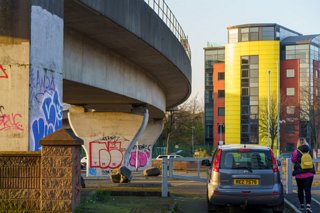I DISLIKE THE FLYOVERS IN BELFAST
The built environment of Belfast City is heavily influenced by car-centric infrastructure, particularly the extensive network of flyovers that crisscross the city centre. While these flyovers may seem like an attempt to bypass the city centre, their history and development are rooted in a complex mix of factors:
Historical Context:
The post-war era saw a significant rise in car ownership in Belfast, as it did in many cities across the world. This increased traffic congestion and led urban planners to seek solutions to improve traffic flow and connectivity. Flyovers were seen as a modern and efficient way to address these challenges.
Urban Planning Philosophy:
The prevailing urban planning philosophy of the time, influenced by modernist ideals, favoured the separation of traffic and pedestrians. This led to the construction of elevated roads and flyovers, often at the expense of the existing urban fabric and pedestrian-friendly spaces.
The Troubles:
The period of conflict known as The Troubles also played a role in shaping Belfast's built environment. Security concerns and the need for controlled movement led to the construction of barriers and checkpoints, further fragmenting the city and prioritizing vehicular traffic over pedestrian access.
Economic Factors:
The decline of traditional industries, such as shipbuilding, led to a focus on attracting investment and promoting economic growth. The development of road infrastructure, including flyovers, was seen as a way to improve access to the city centre and support commercial activity.
Consequences:
While the flyovers may have initially alleviated traffic congestion, they have also created physical barriers and visual blight within the city. They have contributed to a sense of disconnection between different areas of the city, making it less pedestrian-friendly and impacting the overall urban experience.
Changing Attitudes:
In recent years, there has been a growing recognition of the negative impacts of car-centric infrastructure and a shift towards more sustainable and people-centred urban planning approaches. This is evident in the development of new projects that prioritise pedestrian and cyclist access, such as the revitalisation of the Gasworks area and the creation of new green spaces.
The Future of Belfast's Built Environment:
While the flyovers remain a prominent feature of Belfast's cityscape, there is a growing movement to rethink their role and consider alternatives that prioritise people over cars. This could involve repurposing some flyovers for pedestrian or cyclist use, creating new public spaces underneath them, or even removing them altogether in some cases.
Belfast is at a crossroads in terms of its built environment. The city has the opportunity to learn from the past and create a more sustainable, inclusive, and vibrant urban landscape for the future. This will require a shift away from car-centric thinking and a renewed focus on creating spaces that prioritise people, community, and connectivity.
Historical Context:
The post-war era saw a significant rise in car ownership in Belfast, as it did in many cities across the world. This increased traffic congestion and led urban planners to seek solutions to improve traffic flow and connectivity. Flyovers were seen as a modern and efficient way to address these challenges.
Urban Planning Philosophy:
The prevailing urban planning philosophy of the time, influenced by modernist ideals, favoured the separation of traffic and pedestrians. This led to the construction of elevated roads and flyovers, often at the expense of the existing urban fabric and pedestrian-friendly spaces.
The Troubles:
The period of conflict known as The Troubles also played a role in shaping Belfast's built environment. Security concerns and the need for controlled movement led to the construction of barriers and checkpoints, further fragmenting the city and prioritizing vehicular traffic over pedestrian access.
Economic Factors:
The decline of traditional industries, such as shipbuilding, led to a focus on attracting investment and promoting economic growth. The development of road infrastructure, including flyovers, was seen as a way to improve access to the city centre and support commercial activity.
Consequences:
While the flyovers may have initially alleviated traffic congestion, they have also created physical barriers and visual blight within the city. They have contributed to a sense of disconnection between different areas of the city, making it less pedestrian-friendly and impacting the overall urban experience.
Changing Attitudes:
In recent years, there has been a growing recognition of the negative impacts of car-centric infrastructure and a shift towards more sustainable and people-centred urban planning approaches. This is evident in the development of new projects that prioritise pedestrian and cyclist access, such as the revitalisation of the Gasworks area and the creation of new green spaces.
The Future of Belfast's Built Environment:
While the flyovers remain a prominent feature of Belfast's cityscape, there is a growing movement to rethink their role and consider alternatives that prioritise people over cars. This could involve repurposing some flyovers for pedestrian or cyclist use, creating new public spaces underneath them, or even removing them altogether in some cases.
Belfast is at a crossroads in terms of its built environment. The city has the opportunity to learn from the past and create a more sustainable, inclusive, and vibrant urban landscape for the future. This will require a shift away from car-centric thinking and a renewed focus on creating spaces that prioritise people, community, and connectivity.

I DISLIKE THE FLYOVERS IN BELFAST